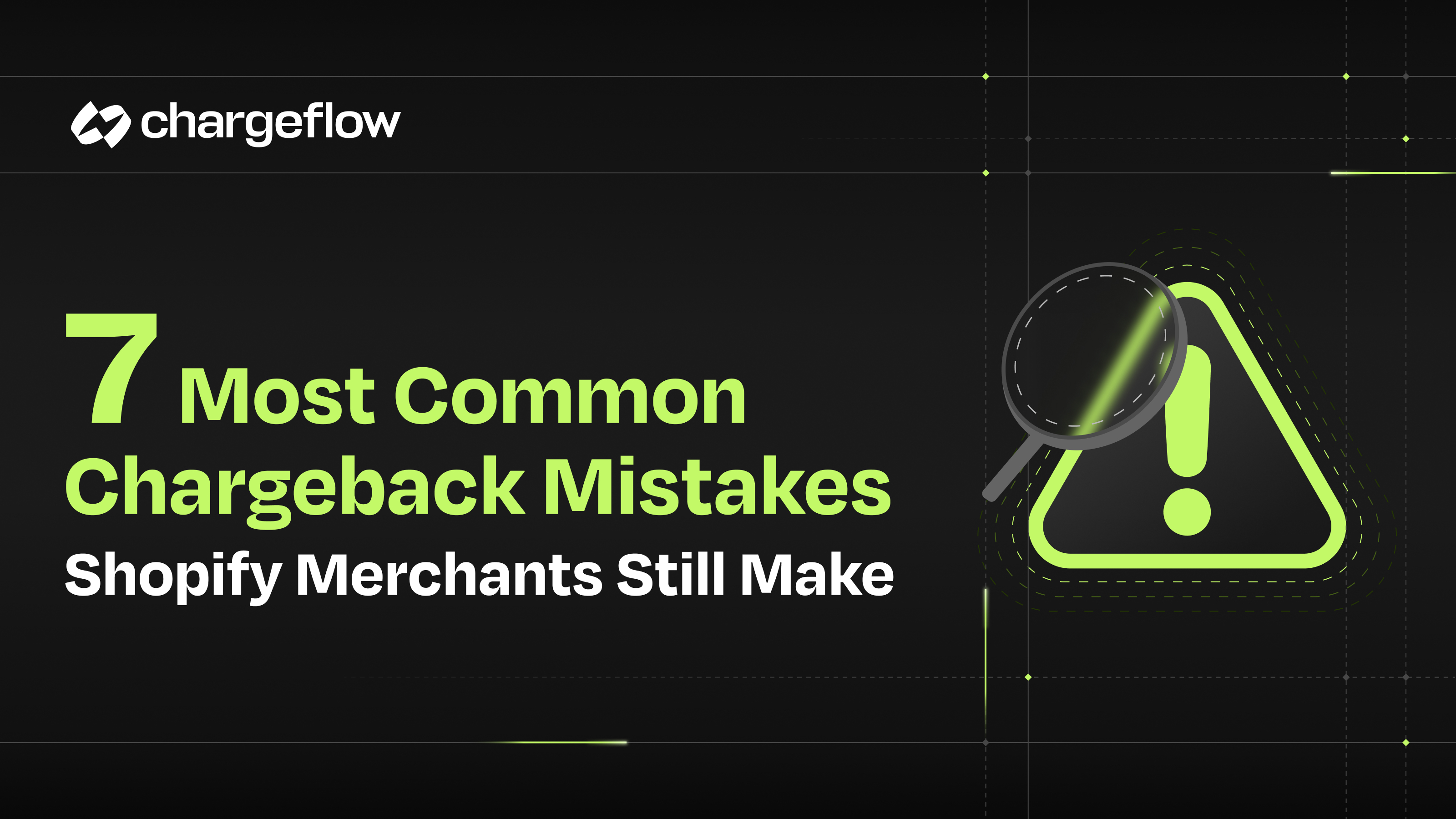How Can You Fight Chargebacks to Protect Your Business Revenue and Reputation? An Ultimate Merchant Guide for 2023

Chargebacks?
No longer your problem.
Recover 4x more chargebacks and prevent up to 90% of incoming ones, powered by AI and a global network of 15,000 merchants.
Equip yourself with effective strategies to fight chargebacks and safeguard your business in 2023. Learn how to protect your revenue from fraud disputes
Chargebacks can be a frustrating and costly problem for any business that accepts credit card payments. When a customer disputes a charge with their bank or credit card issuer, the merchant may be required to refund the payment and face additional chargeback fees.
In this article, we'll explore the process of fighting chargebacks and protecting your business. We'll start by defining what chargebacks are and why they occur, and then we'll dive into the steps you can take to prevent chargebacks from happening in the first place.
We'll also cover the chargeback response process, including how to collect evidence and prepare your response. You'll learn about chargeback representment, a process by which you can challenge a chargeback and potentially recover lost revenue.
By the end of this guide, you'll have a comprehensive understanding of how to fight chargebacks and protect your business from financial losses.
Understand Chargeback Reason Codes to Fight Chargeback
If you're a merchant, you've likely had to deal with chargebacks. Chargebacks occur when a customer disputes a charge on their credit card statement, and the card issuer forcibly reverses the transaction.
Chargebacks can be incredibly frustrating and costly for merchants, but they are unfortunately a fact of life in the payments industry. Understanding chargeback reason codes is a crucial part of fighting chargebacks and protecting your business.
Different Types of Chargeback Reason Codes
Chargeback reason codes are the codes assigned by card networks such as Visa, Mastercard, and American Express to indicate the reason for a chargeback. There are hundreds of different chargeback reason codes, and they can be grouped into several categories. Some common categories of chargeback reason codes include:
1. Fraudulent activity: Chargebacks in this category are typically the result of fraudulent transactions. Examples of fraud-related chargeback reason codes include "fraudulent transaction," "counterfeit transaction," and "card not present transaction."
2. Processing errors: Chargebacks in this category are the result of errors made by the payment processor or merchant. Examples of processing error-related chargeback reason codes include "duplicate transaction," "incorrect transaction amount," and "late presentment."
3. Customer disputes: Chargebacks in this category are the result of a customer disputing a charge on their credit card statement. Examples of customer dispute-related chargeback reason codes include "product not as described," "service not rendered," and "canceled recurring transaction."
Understanding the Meaning of Each Code
Each chargeback reason code has a specific meaning, and it's important to understand the meaning of each code to effectively dispute chargebacks. For example, if you receive a chargeback with the reason code "not as described," you'll need to provide evidence that the product or service was accurately described to the customer.
How to Identify Chargeback Reason Codes?
Identifying chargeback reason codes is an important part of effectively disputing chargebacks. When you receive a chargeback, the reason code should be included in the documentation provided by the payment processor or card issuer. It's important to review the reason code carefully and determine the appropriate course of action to dispute the chargeback.
Preventing Chargebacks to Fix Them
Chargebacks can be a significant problem for businesses. Not only can they result in lost revenue and damage to your reputation, but they can also lead to increased costs and administrative headaches.
That's why it's essential to prevent chargebacks from happening in the first place. In this article, we'll explore some effective strategies for preventing chargebacks and fixing them when they do occur.
1. Address Verification System (AVS)
One of the most effective ways to prevent chargebacks is to use an Address Verification System (AVS). An AVS verifies the billing address of the credit card used for a transaction. By verifying the address, you can ensure that the person making the purchase is the legitimate cardholder.
If the address provided by the cardholder doesn't match the address on file with the issuing bank, the transaction can be declined, preventing fraudulent purchases and chargebacks.
2. Card Verification Value (CVV)
Another effective way to prevent chargebacks is to use the Card Verification Value (CVV). The CVV is a three- or four-digit code on the back of credit cards (or on the front for American Express).
It provides an additional layer of security to verify that the cardholder is making the purchase. If a fraudster has stolen a credit card number but doesn't have the CVV, they won't be able to complete the transaction, reducing the risk of chargebacks.
3. Chargeback Alerts
Many payment processors and banks offer chargeback alerts, which notify you when a chargeback is filed against your business. With chargeback alerts, you can quickly respond to chargebacks, gather evidence, and submit a chargeback response within the time limit.
By responding promptly and effectively, you can prevent chargebacks from being finalized and protect your business.
4. Chargeback Protection Services
Chargeback protection services can also help prevent chargebacks. These services use advanced fraud detection techniques to identify suspicious transactions and prevent fraudulent chargebacks.
Some chargeback protection services also offer representment services, where they will represent chargebacks on your behalf and work to get them overturned.
Chargeback Response Process to Increase Chances of Winning
Chargebacks can result in lost revenue, added expenses, and damage to a company's reputation. However, if you have received a chargeback, don't panic. You can increase your chances of winning the dispute by following a few simple steps in the chargeback response process.
1. Collect Evidence to Dispute the Chargeback
The first step in the chargeback response process is to collect evidence that will support your case. This may include transaction receipts, shipping information, customer emails, and any other relevant documentation. You should also review the chargeback reason code to understand the reason for the dispute and ensure that you have evidence to refute it.
2. Prepare the Chargeback Response
Once you have collected all of the necessary evidence, you can prepare your chargeback response. Your response should be clear, concise, and professional. You should provide a detailed explanation of why the charge was valid and include any relevant evidence to support your case. You should also address the chargeback reason code and explain why it is not applicable in your situation.
3. Communicate Effectively with Customers
Communication is key when it comes to chargeback disputes. You should communicate with your customer throughout the chargeback response process to keep them informed and engaged. You should respond to any customer inquiries promptly and provide updates on the progress of the dispute. Effective communication can help to resolve the dispute quickly and prevent future chargebacks.
4. Submit the Chargeback Response on Time
It is essential to submit your chargeback response on time. Each credit card company has specific time limits for submitting chargeback responses. Failure to meet these time limits can result in an automatic loss of the dispute. Therefore, you should make sure to submit your response before the deadline to increase your chances of winning.
Fight and Protect Chargebacks with Chargeflow
Chargebacks can be a frustrating and costly challenge for businesses of all sizes. Fortunately, Chargeflow offers a comprehensive solution to help fight and protect against chargebacks.
With Chargeflow, businesses can quickly and easily identify chargeback risks, gather evidence to dispute chargebacks, and manage the entire chargeback process from start to finish. This includes automated alerts for potential chargebacks, as well as a user-friendly dashboard that provides real-time updates on the status of each chargeback case.
In addition, Chargeflow provides businesses with valuable insights and analytics to help prevent chargebacks from occurring in the first place. This includes detailed reports on chargeback trends and patterns, as well as recommendations for best practices to reduce chargeback risk.
By leveraging the power of Chargeflow, businesses can effectively fight and protect against chargebacks, while also optimizing their payment processes to minimize future risks.

Chargebacks?
No longer your problem.
Recover 4x more chargebacks and prevent up to 90% of incoming ones, powered by AI and a global network of 15,000 merchants.






























.png)








